国际市场营销双语教学教案10-PPT精品.ppt
- 格式:ppt
- 大小:54.02 KB
- 文档页数:11
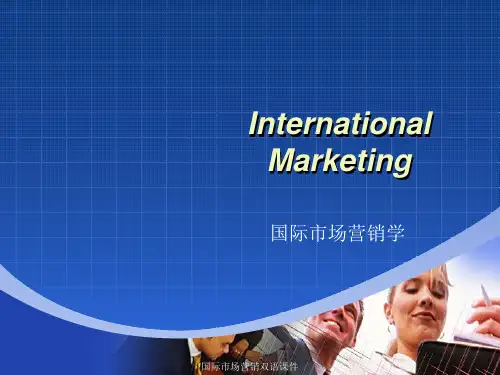
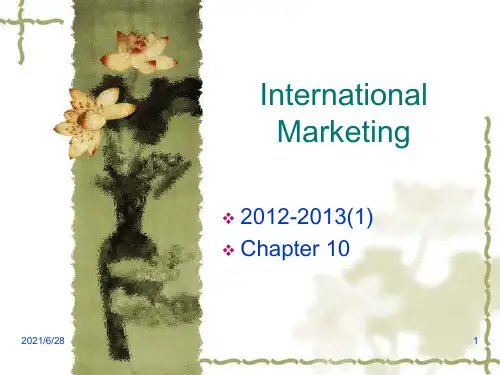
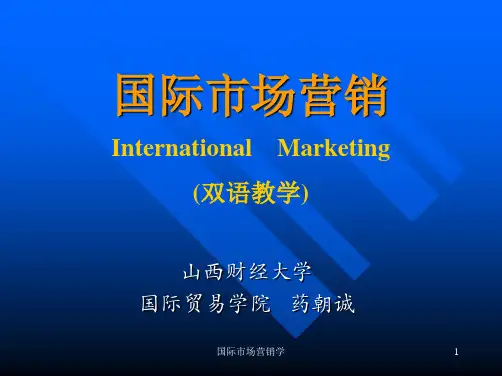
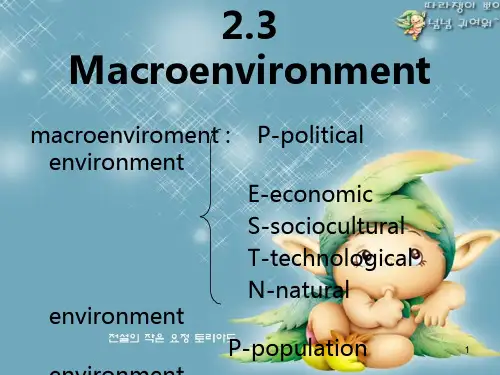
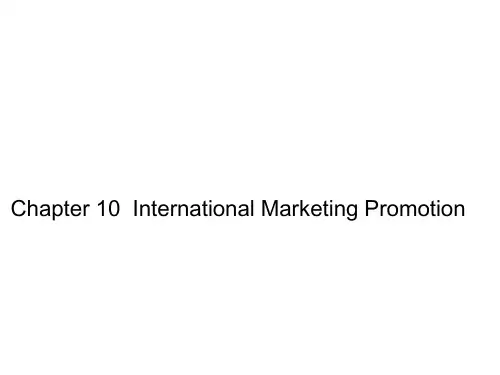
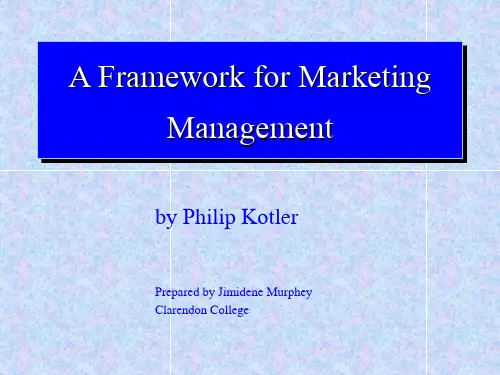

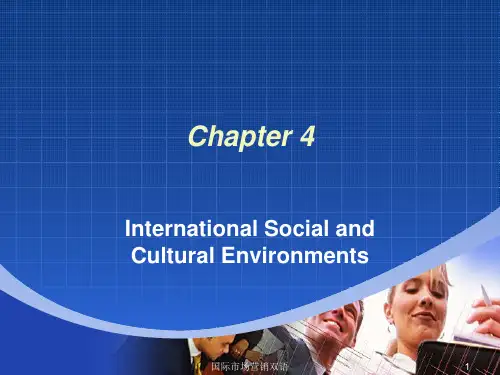

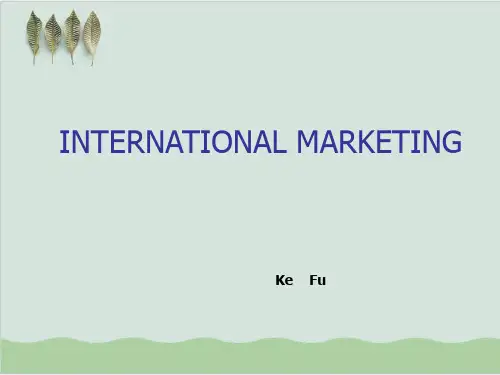
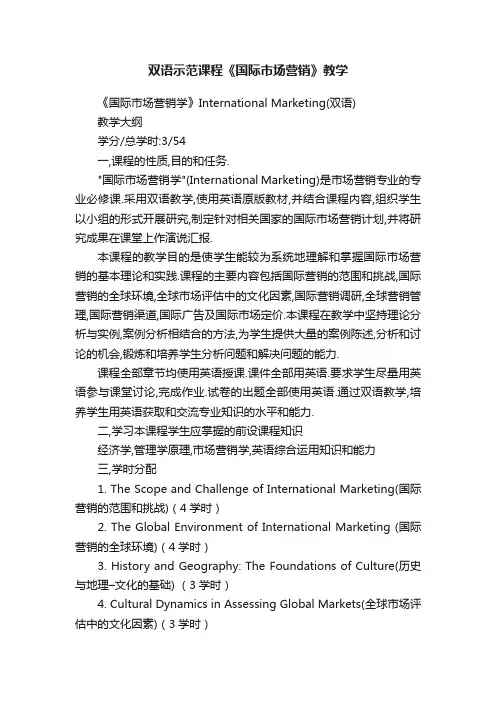
双语示范课程《国际市场营销》教学《国际市场营销学》International Marketing(双语)教学大纲学分/总学时:3/54一,课程的性质,目的和任务."国际市场营销学"(International Marketing)是市场营销专业的专业必修课.采用双语教学,使用英语原版教材,并结合课程内容,组织学生以小组的形式开展研究,制定针对相关国家的国际市场营销计划,并将研究成果在课堂上作演说汇报.本课程的教学目的是使学生能较为系统地理解和掌握国际市场营销的基本理论和实践.课程的主要内容包括国际营销的范围和挑战,国际营销的全球环境,全球市场评估中的文化因素,国际营销调研,全球营销管理,国际营销渠道,国际广告及国际市场定价.本课程在教学中坚持理论分析与实例,案例分析相结合的方法,为学生提供大量的案例陈述,分析和讨论的机会,锻炼和培养学生分析问题和解决问题的能力.课程全部章节均使用英语授课.课件全部用英语.要求学生尽量用英语参与课堂讨论,完成作业.试卷的出题全部使用英语.通过双语教学,培养学生用英语获取和交流专业知识的水平和能力.二,学习本课程学生应掌握的前设课程知识经济学,管理学原理,市场营销学,英语综合运用知识和能力三,学时分配1. The Scope and Challenge of International Marketing(国际营销的范围和挑战)(4学时)2. The Global Environment of International Marketing (国际营销的全球环境)(4学时)3. History and Geography: The Foundations of Culture(历史与地理–文化的基础) (3学时)4. Cultural Dynamics in Assessing Global Markets(全球市场评估中的文化因素)(3学时)5. Culture, Management Style, and Business Systems(文化,管理风格与经营方式) (3学时)6. The Political Environment(政治环境) (3学时)7. The International Legal Environment(国际法律环境) (4学时)8. Developing a Global Vision through Marketing Research(通过营销调研建立全球视野) (4学时)9. Global Marketing Management: Planning and Organization(全球营销管理–计划和组织) (4学时)10. Products and Services for Consumers(面向消费者的产品和服务) (4学时)11. International Marketing Channels(国际营销渠道) (4学时)12. Integrated Marketing Communications and International Advertising(一体化的营销沟通与国际广告) (4学时)13. Personal Selling and Sales Management(人员推销与销售管理) (4学时)14. Pricing for International Markets(国际市场定价) (4学时)15. Review(2学时)四,课程基本要求和内容Part One: An OverviewChapter1:The Scope and Challenge of International Marketing(国际营销的范围和挑战)4学时Learning Objectives(基本要求):T o learn and understand the followings: the scope of the international marketing task; the importance of the cross-cultural analysis in international marketing; the progression of becominga global marketer; the increasing importance of global awareness.1. International Marketing Defined2. The International Marketing Task3. Environmental Adaptation Needed4. The Self-Reference Criterion and Ethnocentrism5. Developing a Global Awareness6. Stages of International Marketing Involvement7. Strategic Orientation8. The Orientation of International MarketingChapter2:The Global Environment of International Marketing (国际营销的全球环境)4学时Learning Objectives(基本要求):To learn and understand the followings: the importance of GA TT and the World Trade Organization; the emergence of the International Monetary Fund and the World Bank Group; the evolution of the European Community to the European Union; the trade linkage of NAFTA and South America and its regional effects; the development of trade within the Asia-Pacific Rim; the growth of developing markets and their importance to regional trade.1. GATT and WTO2. The International Monetary Fund and World Bank Group3. Protests against Global Institutions4. Global Markets and Multinational Market Groups5. Marketing in a Developing CountryPart Two: The Cultural Environment of Global MarketsChapter3: History and Geography: The Foundations of Culture(历史与地理–文化的基础)3学时Learning Objectives(基本要求):To learn and understand the following: the importance of history and geography in the understanding of international markets; the effects of history on a country's culture; effect of geographic diversity on economic profiles of a country; economic effects of controlling population growth versus aging population.1. Historical Perspective in Global Business2. Geography and Global Markets3. Dynamics of Global Population Trends4. World Trade RoutesChapter4: Cultural Dynamics in Assessing Global Markets(全球市场评估中的文化因素)3学时Learning Objectives(基本要求):To learn and understand the following: the importance of culture to an international marketer; the origins and elements of culture; the impact of cultural borrowing;the strategy of planned change and its consequences.1. Culture's Pervasive Impact2. Definitions and Origins of Culture3. Elements of Culture4. Cultural Knowledge5. Cultural ChangeChapter5: Culture, Management Style, and Business Systems(文化,管理风格与经营方式)4学时Learning Objectives(基本要求):To learn and understand the following: the necessity for adapting to cultural differences; how and why management styles vary around the world; the extent and implications of gender bias in some countries; the importance of cultural differences in business ethics; the differences between relationship-oriented and information-oriented cultures.1. Required Adaptation2. Management Styles around the World3. Gender Bias in International Business4. Business Ethics5. Culture's Influence on Strategic Thinking6. A Synthesis, Relationship-Oriented versus Information-Oriented CulturesChapter6: The Political Environment: A Critical Concern (政治环境)4学时Learning Objectives(基本要求):To learn and understand the following: what the sovereignty of nations means and how it affects the stability of government policies, political parties, and nationalism; the political risks of global business and the factors that affect stability; the importance of the political system to international marketing and its effects on foreign investments; assessing and reducing the effects of political vulnerability.1. The Sovereignty of Nations2. Stability of Government Policies3. Political Risks of Global Business4. Assessing Political Vulnerability5. Reducing Political VulnerabilityChapter7: The International Legal Environment(国际法律环境)4学时Learning Objectives(基本要求):To learn and understand the following: the four heritages of today's legal systems; the important factors in jurisdiction of legal disputes; issues associated with jurisdiction of legal disputes and the various methods of dispute resolution; the unique problemsof protecting intellectual property rights internationally; ways to protect against piracy and counterfeiting; the legal differences between countries and how the differences can affect international marketing plans.1. Bases for Legal Systems2. Jurisdiction in International Legal Disputes3. International Dispute Resolution4. Protection of Intellectual Property Rights5. Commercial Law within CountriesPart three: Developing Global Marketing StrategiesChapter 8: Developing a Global Vision through MarketingResearch(通过营销调研建立全球视野)4学时Learning Objectives(基本要求):To learn and understand the following: the importance of problem definition in international research; the problems of availability and use of secondary data; quantitative and qualitative research methods; sources of secondary data; how to analyze and use research information.1. Breadth and Scope of International Marketing Research2. The Research Process3. Defining the Problem and Establishing Research Objectives4. Problems of Availability and Use of Secondary Data5. Gathering Primary Data: Quantitative and Qualitative Research6. Multicultural Research: A Special Problem7. Research on the Internet: A Growing Opportunity8. Estimating Market Demand9. Problems in Analyzing and Interpreting Research Information10. Responsibility for Conducting Marketing Research11. Communicating with Decision MakersChapter9: Global Marketing Management: Planning and Organization(全球营销管理–计划和组织)4学时Learning Objectives(基本要求):To learn and understand the following: how global marketing management differs from international marketing management; the increasing importance of international strategic alliances; the need for planning to achieve company goals; the important factors for each alternative market-entry strategy.1. Global Marketing Management: An Old Debate and a New View2. Planning for Global Markets3. Alternative Market-Entry Strategy4. Organizing for Global CompetitionChapter10: Products and Services for Consumers(面向消费者的产品和服务)4学时Learning Objectives(基本要求):To learn and understand the following: the importance of offering a product suitable for the intended market; the importance of quality and how quality is defined; country-of-origin effects on product image; physical, mandatory, and cultural requirements for product adaptation; the need to view all attributes of a product in order to overcome resistance to acceptance.1. Quality2. Products and Culture3. Analyzing Product Components for Adaptation4. Marketing Consumer Services Globally5. Brands in International MarketsChapter11: International Marketing Channels(国际营销渠道)4学时Learning Objectives(基本要求):To learn and understand the followings: the variety of distribution channels and how they affect cost and efficiency in marketing; how distribution patterns affect the various aspects of international marketing; the growing importance of e-commerce as a distribution alternative; the functions, advantages, and disadvantages of various kinds of middlemen; the importance of middlemen to a product's success and the importance of selecting and maintaining middlemen.1. Channel-of-Distribution Structures2. Distribution Patterns3. Alternative Middleman Choices4. Factors Affecting Choices of Channels5. Locating, Selecting, and Motivating Channel Members6. The InternetChapter12: Integrated Marketing Communications and International Advertising(一体化的营销沟通与国际广告)4学时Learning Objectives(基本要求):To learn and understand the followings: local market characteristics that affect the advertising and promotion of products; the strengths and weaknesses of sales promotion and public relations in global marketing; when global advertising is most effective; when modified advertising is necessary; the effect of limited media, excessive media, and government regulations on advertising and promotion budgets.1. Sales Promotions in International Markets2. International Public Relations3. International Advertising4. Advertising Strategy and Goals5. The Message: Creative Challenge6. Media Planning and Analysis7. Campaign Execution and Advertising Agency8. International Control of AdvertisingChapter13: Personal Selling and Sales Management(人员推销与销售管理)4学时Learning Objectives(基本要求):To learn and understand the followings: the role of interpersonal selling in international marketing; the considerations in designing an international sales force; the steps to recruiting three types of international sales people; selection criteria for international sales and marketing positions; the special training needs of international personnel; motivation techniques for international sales representatives; how to design compensation systems for an international salesforce; the changing profile of the global sales and marketing manager.1. Designing the Sales Force2. Recruiting Marketing and Sales Personnel3. Selecting Sales and Marketing Personnel4. Training for International Marketing5. Motivating Sales Personnel6. Designing Compensation Systems7. Evaluating and Controlling Sales Representatives8. Developing Cultural Awareness9. The Changing Profile of the Global Manager10. Foreign Language SkillsChapter14: Pricing for International Markets(国际市场定价)4学时Learning Objectives(基本要求):To learn and understand the following: components of pricing as competitive tools in international marketing; the pricing pitfalls directly related to international marketing; how to control pricing in parallel imports or gray markets; price escalation and how to minimize its effect; countertrading and its place in international marketing practices; the mechanisms of price quotations.1. Pricing Policy2. Approaches to International Pricing3. Price Escalation4. Approaches to Lessening Price Escalation5. Leasing in International Markets6. Countertrade as a Pricing Tool7. Transfer Pricing Strategy8. Price Quotation9. Administered PricingPart Four :Supplementary Material五,教材及学生参考书教材:Philip Cateora等著International Marketing(国际营销)12th Edition(第12版) 中国人民大学出版社2005年3月参考书:1,Michael R. Czinkota著International Marketing(国际商务) 8th Edition(第8版) 北京大学出版社2007年10月。
国际市场营销双语教学教案第一章:国际市场营销概述1.1 教学目标了解国际市场营销的定义和重要性掌握国际市场营销的基本概念和原则理解国际市场营销的环境和趋势1.2 教学内容国际市场营销的定义和重要性国际市场营销的基本概念和原则国际市场营销的环境和趋势1.3 教学方法讲授:讲解国际市场营销的定义和重要性,介绍基本概念和原则案例分析:分析国际市场营销的成功案例,让学生更好地理解国际市场营销的应用1.4 教学评估小组讨论:学生分组讨论国际市场营销的成功案例,分享自己的观点和经验课堂测试:设计相关的选择题和简答题,测试学生对国际市场营销的基本概念和原则的理解第二章:国际市场营销环境分析2.1 教学目标了解国际市场营销环境的组成和影响因素掌握PESTEL分析工具,对国际市场营销环境进行分析了解国际市场营销环境的发展趋势2.2 教学内容国际市场营销环境的组成和影响因素PESTEL分析工具的介绍和应用国际市场营销环境的发展趋势2.3 教学方法讲授:讲解国际市场营销环境的组成和影响因素,介绍PESTEL分析工具小组讨论:学生分组讨论国际市场营销环境的案例,运用PESTEL分析工具进行分析2.4 教学评估小组报告:学生分组进行报告,分享他们对国际市场营销环境案例的分析结果课堂测试:设计相关的问题,测试学生对PESTEL分析工具的应用和国际市场营销环境的发展趋势的理解第三章:国际市场营销策略3.1 教学目标了解国际市场营销策略的类型和选择掌握国际市场营销策略的基本原则和步骤了解国际市场营销策略的成功案例3.2 教学内容国际市场营销策略的类型和选择国际市场营销策略的基本原则和步骤国际市场营销策略的成功案例3.3 教学方法讲授:讲解国际市场营销策略的类型和选择,介绍基本原则和步骤案例分析:分析国际市场营销策略的成功案例,让学生更好地理解策略的应用3.4 教学评估小组讨论:学生分组讨论国际市场营销策略的成功案例,分享自己的观点和经验课堂测试:设计相关的问题,测试学生对国际市场营销策略的理解和应用能力第四章:国际市场营销渠道和物流4.1 教学目标了解国际市场营销渠道的类型和功能掌握国际市场营销渠道的选择和管理了解国际市场营销物流的流程和重要性4.2 教学内容国际市场营销渠道的类型和功能国际市场营销渠道的选择和管理国际市场营销物流的流程和重要性4.3 教学方法讲授:讲解国际市场营销渠道的类型和功能,介绍选择和管理的方法案例分析:分析国际市场营销渠道和物流的成功案例,让学生更好地理解应用4.4 教学评估小组讨论:学生分组讨论国际市场营销渠道和物流的成功案例,分享自己的观点和经验课堂测试:设计相关的问题,测试学生对国际市场营销渠道和物流的理解和应用能力第五章:国际市场营销推广和沟通5.1 教学目标了解国际市场营销推广的工具和策略掌握国际市场营销推广的基本原则和步骤了解国际市场营销沟通的重要性和方法5.2 教学内容国际市场营销推广的工具和策略国际市场营销推广的基本原则和步骤国际市场营销沟通的重要性和方法5.3 教学方法讲授:讲解国际市场营销推广的工具和策略,介绍基本原则和步骤案例分析:分析国际市场营销推广和沟通的成功案例,让学生更好地理解应用5.4 教学评估小组讨论:学生分组讨论国际市场营销推广和沟通的成功案例,分享自己的观点和经验课堂测试:设计相关的问题,测试学生对国际市场营销推广和沟通的理解和应用能力第六章:国际市场营销文化差异与适应6.1 教学目标了解不同文化对国际市场营销的影响掌握跨文化沟通的原则和策略了解如何适应不同文化的市场营销策略6.2 教学内容不同文化对国际市场营销的影响跨文化沟通的原则和策略适应不同文化的市场营销策略6.3 教学方法讲授:讲解不同文化对国际市场营销的影响,介绍跨文化沟通的原则和策略小组讨论:学生分组讨论文化差异对国际市场营销的影响,分享跨文化沟通的实践经验6.4 教学评估小组报告:学生分组进行报告,分享他们对文化差异对国际市场营销的影响的理解和跨文化沟通的实践经验课堂测试:设计相关问题,测试学生对不同文化对国际市场营销的影响和适应不同文化的市场营销策略的理解第七章:国际市场营销法律、伦理和社会责任7.1 教学目标了解国际市场营销中的法律和伦理问题掌握国际市场营销中的法律和伦理原则了解国际市场营销中的社会责任7.2 教学内容国际市场营销中的法律和伦理问题国际市场营销中的法律和伦理原则国际市场营销中的社会责任7.3 教学方法讲授:讲解国际市场营销中的法律和伦理问题,介绍法律和伦理原则小组讨论:学生分组讨论国际市场营销中的法律和伦理问题,分享对社会责任的理解7.4 教学评估小组报告:学生分组进行报告,分享他们对国际市场营销中的法律、伦理和社会责任的理解课堂测试:设计相关问题,测试学生对国际市场营销中的法律和伦理问题的理解以及对社会责任的认识第八章:国际市场营销计划和实施8.1 教学目标了解国际市场营销计划的结构和内容掌握国际市场营销计划的制定和实施步骤了解国际市场营销计划的评估和调整方法8.2 教学内容国际市场营销计划的结构和内容国际市场营销计划的制定和实施步骤国际市场营销计划的评估和调整方法8.3 教学方法讲授:讲解国际市场营销计划的结构和内容,介绍制定和实施的步骤案例分析:分析国际市场营销计划的案例,让学生更好地理解应用8.4 教学评估小组讨论:学生分组讨论国际市场营销计划的案例,分享自己的观点和经验课堂测试:设计相关问题,测试学生对国际市场营销计划的理解和应用能力第九章:国际市场营销案例分析9.1 教学目标了解国际市场营销案例分析的方法和技巧掌握国际市场营销案例分析的工具和步骤了解国际市场营销案例的成功经验和教训9.2 教学内容国际市场营销案例分析的方法和技巧国际市场营销案例分析的工具和步骤国际市场营销案例的成功经验和教训9.3 教学方法讲授:讲解国际市场营销案例分析的方法和技巧,介绍工具和步骤小组讨论:学生分组讨论国际市场营销案例,运用分析和技巧进行深入探讨9.4 教学评估小组报告:学生分组进行报告,分享他们对国际市场营销案例分析的理解和应用课堂测试:设计相关问题,测试学生对国际市场营销案例分析的方法和技巧的掌握第十章:国际市场营销的未来趋势10.1 教学目标了解国际市场营销的最新发展趋势掌握影响国际市场营销未来发展的因素了解国际市场营销的未来挑战和机遇10.2 教学内容国际市场营销的最新发展趋势影响国际市场营销未来发展的因素国际市场营销的未来挑战和机遇10.3 教学方法讲授:讲解国际市场营销的最新发展趋势,介绍影响未来发展的因素小组讨论:学生分组讨论国际市场营销的未来挑战和机遇,分享自己的观点和看法10.4 教学评估小组报告:学生分组进行报告,分享他们对国际市场营销最新发展趋势的理解和对未来挑战和机遇的认识课堂测试:设计相关问题,测试学生对国际市场营销的未来发展趋势的理解和认识重点和难点解析1. 教学目标:明确教学目标,确保教学内容能够满足学生的学习需求。